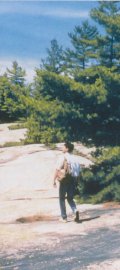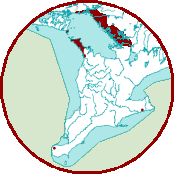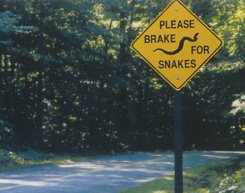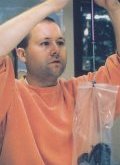
 The Eastern Georgian
Bay shoreline, blessed with numerous islands and a diverse interior habitat,
represents the largest land area where the massasauga rattlesnake may be
found. The area is comprised of mixed forests, areas of exposed bedrock,
and wetlands, including marshes, swamps, fens, and bogs. The massasauga
is symbolic of the natural Georgian Bay ecosystem. Like the moose or
black bear, the snake is respected and admired by many for its uniqueness
as a part of Ontario’s natural world. Despite the large area,
many massasauga populations in this region are under threat and in danger
of declining.
The Eastern Georgian
Bay shoreline, blessed with numerous islands and a diverse interior habitat,
represents the largest land area where the massasauga rattlesnake may be
found. The area is comprised of mixed forests, areas of exposed bedrock,
and wetlands, including marshes, swamps, fens, and bogs. The massasauga
is symbolic of the natural Georgian Bay ecosystem. Like the moose or
black bear, the snake is respected and admired by many for its uniqueness
as a part of Ontario’s natural world. Despite the large area,
many massasauga populations in this region are under threat and in danger
of declining.
National and provincial parks within the region offer
some protection for rattlesnakes. Remote areas with ideal massasauga habitat
and limited disturbance still exist and harbour rattlesnake populations that
are presumably healthy. However, the natural beauty of the Georgian Bay region
has led to intense development in some areas. Eastern Georgian Bay
is the heart of southern Ontario’s cottage country and a prime area
for cottages, recreation, and residential development. As development
progresses into previously undisturbed areas, the chance of these activities
impacting on the massasauga populations and other wildlife increases.
 With increased development comes more roads. To reduce
snake highway mortalities, officials have posted snake crossing road signs
in Killbear Provincial Park. They alert drivers to the possibility
that snakes might be on the road. Hopefully people will slow down and
pay closer attention to not just snakes but all animals crossing roads inside
and outside of the Park. These signs have also been erected in other areas
where the massasauga exists.
With increased development comes more roads. To reduce
snake highway mortalities, officials have posted snake crossing road signs
in Killbear Provincial Park. They alert drivers to the possibility
that snakes might be on the road. Hopefully people will slow down and
pay closer attention to not just snakes but all animals crossing roads inside
and outside of the Park. These signs have also been erected in other areas
where the massasauga exists.
 Wildlife
biologists have been studying the region's eastern massasauga rattlesnakes
since 1990. The research involves locating rattlesnakes within the
park, measuring and marking them for individual identification, and collecting
blood samples for DNA analysis. The researchers also implant some of the
snakes with a radio transmitter and track them. This method of research helps
biologists discover movements and the preferred habitat of the massasauga.
Wildlife
biologists have been studying the region's eastern massasauga rattlesnakes
since 1990. The research involves locating rattlesnakes within the
park, measuring and marking them for individual identification, and collecting
blood samples for DNA analysis. The researchers also implant some of the
snakes with a radio transmitter and track them. This method of research helps
biologists discover movements and the preferred habitat of the massasauga.
Using these observations, Parks Canada has been developing
a habitat suitability model. This kind of research will help provide
better answers for future conservation efforts for the massasauga.



© Brent Huffman, Toronto Zoo
2005

 The Eastern Georgian
Bay shoreline, blessed with numerous islands and a diverse interior habitat,
represents the largest land area where the massasauga rattlesnake may be
found. The area is comprised of mixed forests, areas of exposed bedrock,
and wetlands, including marshes, swamps, fens, and bogs. The massasauga
is symbolic of the natural Georgian Bay ecosystem. Like the moose or
black bear, the snake is respected and admired by many for its uniqueness
as a part of Ontario’s natural world. Despite the large area,
many massasauga populations in this region are under threat and in danger
of declining.
The Eastern Georgian
Bay shoreline, blessed with numerous islands and a diverse interior habitat,
represents the largest land area where the massasauga rattlesnake may be
found. The area is comprised of mixed forests, areas of exposed bedrock,
and wetlands, including marshes, swamps, fens, and bogs. The massasauga
is symbolic of the natural Georgian Bay ecosystem. Like the moose or
black bear, the snake is respected and admired by many for its uniqueness
as a part of Ontario’s natural world. Despite the large area,
many massasauga populations in this region are under threat and in danger
of declining.
 With increased development comes more roads. To reduce
snake highway mortalities, officials have posted snake crossing road signs
in Killbear Provincial Park. They alert drivers to the possibility
that snakes might be on the road. Hopefully people will slow down and
pay closer attention to not just snakes but all animals crossing roads inside
and outside of the Park. These signs have also been erected in other areas
where the massasauga exists.
With increased development comes more roads. To reduce
snake highway mortalities, officials have posted snake crossing road signs
in Killbear Provincial Park. They alert drivers to the possibility
that snakes might be on the road. Hopefully people will slow down and
pay closer attention to not just snakes but all animals crossing roads inside
and outside of the Park. These signs have also been erected in other areas
where the massasauga exists.
 Wildlife
biologists have been studying the region's eastern massasauga rattlesnakes
since 1990. The research involves locating rattlesnakes within the
park, measuring and marking them for individual identification, and collecting
blood samples for DNA analysis. The researchers also implant some of the
snakes with a radio transmitter and track them. This method of research helps
biologists discover movements and the preferred habitat of the massasauga.
Wildlife
biologists have been studying the region's eastern massasauga rattlesnakes
since 1990. The research involves locating rattlesnakes within the
park, measuring and marking them for individual identification, and collecting
blood samples for DNA analysis. The researchers also implant some of the
snakes with a radio transmitter and track them. This method of research helps
biologists discover movements and the preferred habitat of the massasauga.